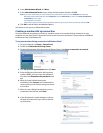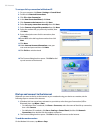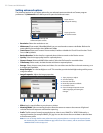
Chapter 10
Navigating on the Road
10.1 Guidelines and Preparation for Using
GPS
If you installed a GPS navigation software on your device, follow these guidelines before and when using your
device for GPS navigation.
When using GPS navigation software in the car, always plot your GPS route before starting to drive. Do
not try to configure the GPS navigation software while driving.
The plotted GPS route is only for driving reference. It should not interfere with actual driving behavior.
Do not leave your device in a vehicle or expose the device to direct sunlight to avoid overheating the
battery, which could pose damage to the device or risk to the vehicle.
When using the device inside a vehicle, use the car holder to mount the device securely in place. Avoid
placing the device in the areas shown in the following diagram:
1 Do not place where it will block the driver’s vision.
2 Do not place where air bags could deploy.
3 Do not place anywhere in the vehicle without securing the device in the holder.
Use the GPS system cautiously. Users shall be liable for any damages resulting from negligent operation
of the system.
The GPS signal cannot pass through solid non-transparent objects. Signal reception may be affected by
obstructions such as high-rise buildings, tunnels, bridges, forests, weather (rainy or cloudy days), etc. If
the vehicle’s visor contains metal, it will be difficult for the GPS signal to pass through.
Other nearby wireless communication products (such as mobile phones or radar-detecting devices) may
interfere with the satellite signal, resulting in unstable signal reception.
The Global Positioning System (GPS) is built and operated by the US Defense Department. The
Department is responsible for the accuracy and maintenance of the system. Any changes that the
Department makes may affect the accuracy and function of the GPS system.
•
•
•
•
•
•
•
•


















